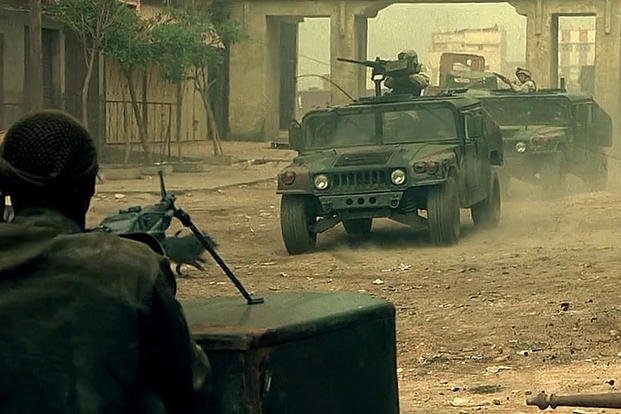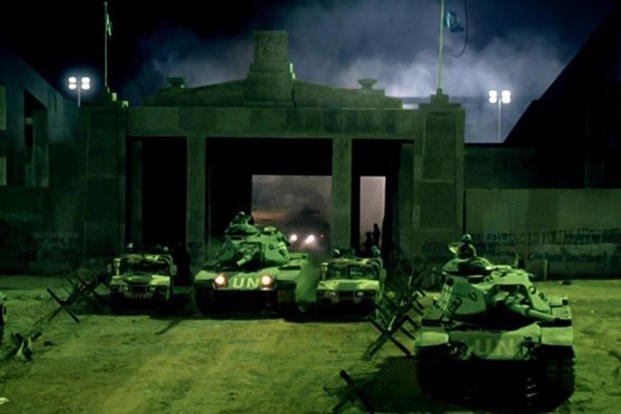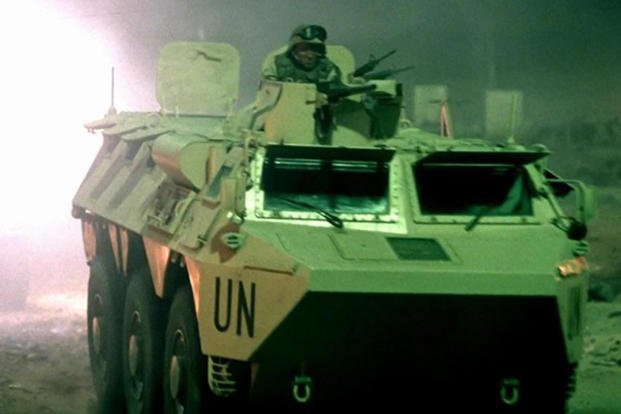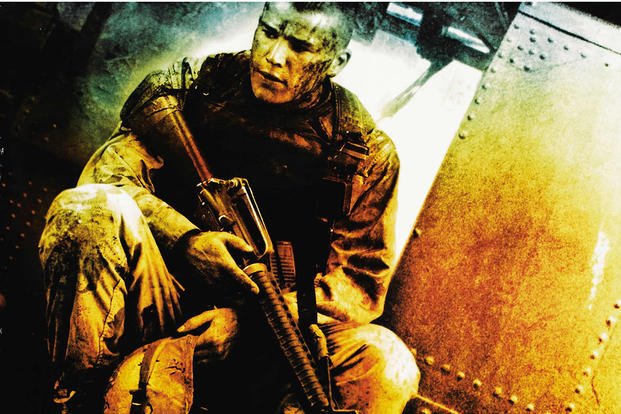"RPG!"
The three-letter warning for rocket-propelled grenades became famous in 2001's "Black Hawk Down." There might be no phrase that's more strongly associated with movies about the Global War on Terror, but it got its start on the silver screen before a single U.S. service member set foot in Afghanistan or Iraq (the second time).
"Black Hawk Down" follows the U.S. soldiers of Task Force Ranger through a chaotic battle in Mogadishu, Somalia, that famously left 18 soldiers dead, 73 wounded or injured, and two UH-60 Black Hawk helicopters shot down. If it isn't your favorite war movie of all time, it has to at least be in the running. The story of Operation Gothic Serpent (what a name) blends heartbreak with heroism and offers a tragic foreshadowing of the decades that followed.
The film's release was particularly poignant in the aftermath of the Sept. 11, 2001, terror attakcs, but it would have held up as an elite movie regardless of its release date. During the 2002 Academy Awards, it won two Oscars and received nominations for two more. The star-studded cast included Eric Bana, Orlando Bloom, William Fichtner, Josh Hartnett, Jason Isaacs, Ewan McGregor and Tom Sizemore.
There's a lot going on in this action-packed war drama, so don't blame yourself if you missed a few details here and there. In addition to all the names, faces, gear and fast-paced events, there are a few military vehicles that deserve recognition.
These are the U.S. military vehicles of "Black Hawk Down" -- including a few surprises.
Humvee

The original extraction plan for Operation Gothic Serpent involved a convoy of ground vehicles -- mostly Humvees -- returning the American soldiers and their Somali prisoners to safety. But no plan, as we know, survives contact with the enemy.
As Staff Sgt. Jeff Struecker (played by Brian Van Holt) leads his convoy of Humvees away from the objective, the vehicle's shortcomings start to reveal themselves. Turret gunners wield heavy machine guns but have no protection from Somali fighters firing down from the rooftops. This leads to one of the film's most famous lines after one of the turret gunners is killed: "Get on that .50!"
When a second convoy, led by Lt. Col. Danny McKnight (Sizemore), struggles to navigate the hostile streets of Mogadishu and return to base, bullets and RPGs sail right through the aluminum doors and unarmored windshields. McKnight's driver, blinded by shards of windshield, mashes the accelerator while McKnight steers with one hand from the passenger seat.
For current service members, the Humvee is a relic of another time. The battle depicted in "Black Hawk Down" shined a light on the vehicle's vulnerability in urban warfare and illustrates why the Pentagon is keen on replacing it.
M35A2 Cargo Truck

The situation turns from bad to worse once the first U.S. soldiers depart the objective, and McKnight finds out over the radio while he takes cover behind a large Army truck. That rig is an M35A2 cargo truck.
The M35A2 "deuce-and-a-half" featured in "Black Hawk Down" offers McKnight's soldiers significantly more cargo room and power than a Humvee. But the convoy's M35A2 doesn't have the protection of a turret-mounted machine gun. It also lacks armor, and the soldier in the passenger seat is hit by an RPG that lodges in his torso but fails to detonate.
According to the automotive publication Motor Trend, the Kaiser Jeep Corporation started building the M35A2 2.5-ton truck in the 1960s (the original M35 dates back to 1949, according to the automotive site Hemmings). In addition to its 10,000 payload capacity and impressive off-road performance, the M35A2 is famously capable of running on just about any flammable substance you can pour into the fuel tank. That's a huge advantage on the battlefield, where fresh diesel might be scarce and diesel exhaust fluid (DEF) is nonexistent.
M60A3 Patton

When McKnight returns to the fight after evacuating casualties and restocking the convoy's ammunition, we see three M60A3 Patton tanks guarding the gate to the soccer stadium that's being used as a rally point. One appears to be leading the convoy, but since it's never shown again, it's possible that this tank was either getting out of the way or included in the movie as an artistic show of force.
The tanks in "Black Hawk Down" bear U.N. markings, suggesting that they were not under the American command's control. According to the Army's First Division Museum, the M60 Patton tank began service in 1960, making the platform old enough to be conceivably farmed out to partner nations by 1993.
M113 Armored Personnel Carrier

By the time the United Nations rescue convoy reaches the beleaguered American soldiers stranded in Mogadishu, it's clear that the mission's original light-and-fast approach isn't going to cut it. The M113 Armored Personnel Carrier (APC) has tracks instead of tires and steel armor capable of blocking incoming small-arms fire.
The M113 gets limited screen time because it's part of a U.N. convoy that barely sticks around long enough to pick up American casualties.
An armored personnel carrier, such as the M113, would have been a welcome sight to a soldier stranded in a fierce urban firefight. Even though the turret gunner would have been exposed, those inside would have enjoyed protection from small-arms fire.
Véhicules de l'Avant Blindé

Right behind the M113, there are a few vehicles that you might not recognize. They're real military vehicles, just not American ones.
What you see are Véhicules de l'Avant Blindé (VAB) marked with "UN" monikers. The crew members are wearing blue helmets, indicating that they're part of an international contingent rather than the U.S. Army. Maybe that's why they turn away American soldiers who are exhausted and nearly out of ammunition, instead of honoring the old adage that there's always room for one more.
According to Army Technology, the VAB is a French-made armored personnel carrier that's been in use since 1976. The six-wheel-drive vehicle has a 300-horsepower Renault turbo diesel engine, one of several turret-mounted weapons, seating for 12, and armor capable of deflecting small-arms fire. It's not exactly a rolling fortress, but riding in one would have been a lot better than running through the maze-like streets of Mogadishu under sustained enemy gunfire.
Bonus: M1008 Commercial Utility Cargo Vehicle

At one point in the movie, American soldiers take fire from Somali fighters in the back of a pickup truck. This isn't the stereotypical Toyota Hilux, though; it's a long-bed Chevy.
How did a Chevy end up in Somalia? Is this lazy prop design? What you see there isn't the Chevy K10 sold on the civilian market, it's a U.S. Army M1008 Commercial Utility Cargo Vehicle (CUCV). According to Motor Trend, General Motors upgraded its civilian-market pickups with a naturally aspirated 6.2-liter diesel engine instead of a gasoline-burning V8 or turbodiesel. Heavy-duty upgrades included a stronger transmission, transfer case and axles. The M1008 even had a locking rear differential.
Given the ubiquitous presence of the U.S. military in troubled parts of the world, it's reasonable to imagine that a surplus vehicle got sold to a local buyer at some point. If I were living in a war-torn country with nonexistent infrastructure, a heavy-duty truck with a rock-solid diesel engine and off-roading credentials would be very appealing.
The Legacy of "Black Hawk Down"

The combat depicted in "Black Hawk Down" is etched into the memory of a generation of Americans, many of whom went on to serve during the decadeslong Global War on Terror. In Somalia, the wounds of the 1990s have yet to heal, and life there is just as complex and dangerous as it was when American helicopters were buzzing above the rooftops.
It's understandable that the fight's Humvees, trucks and armored vehicles took a back seat to Black Hawk and Little Bird helicopters in our collective memory, but they still deserve credit for getting American soldiers out of harm's way when time was running out.
Want to Know More About the Military?
Be sure to get the latest news about the U.S. military, as well as critical info about how to join and all the benefits of service. Subscribe to Military.com and receive customized updates delivered straight to your inbox.











